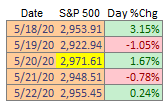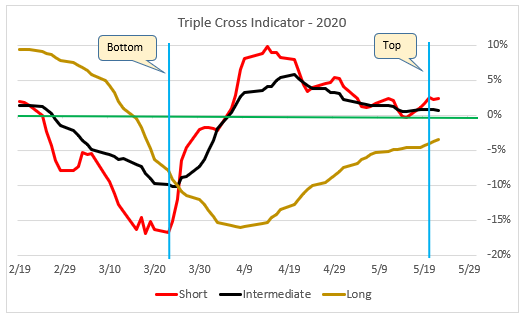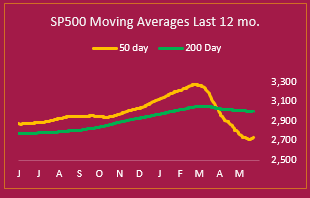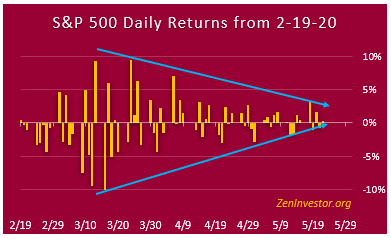The week just past
It was a strong week, up 3.2% on the S&P 500. But not an exceptional week compared to what we've seen so far this year. But a win is a win, and we'll take it.
Last week we had one big up day (Monday), one above average up day (Wednesday), and three mediocre days.. The net result was a gain of 3.2% for the week.
The Triple Cross Indicator
Next up is a new chart in the lineup. The Triple Cross chart plots three moving average crossovers - short, intermediate, and long. The idea is to give you a sense of market momentum at these three time frames.
In a normal upward trending market, all three lines will be above zero. In a bear market they will be below zero. In between, the short moving average (red line) acts like the canary in the coal mine and warns of possible trouble ahead. This line is very twitchy, so only the most active traders should act on it.
The intermediate moving average (black line) isn't as twitchy as the red line. It avoids some of the whipsaws that the red line can cause. When the black line moves above or below zero it's a good indication that the intermediate trend in the market has changed.
The long moving average (brown line) serves as confirmation that what the other two lines are saying is sustainable. Each investor must decide for themselves how to use the information provided by the three moving average crossovers.
The way I interpret this chart today is that the rally from March 23 is losing momentum but is still going.
The Death Cross
Next we have the dreaded Death Cross. Note the uptick in the 50 day moving average. But the 200 day is still in decline. We are still in the grip of the death cross.
The Compression of Daily Volatility
Lastly, we have the compression of daily market swings. Monday's 3.15% gain has shifted the top blue line slightly higher but the compression is still clearly visible. Two months ago we were seeing daily swings of 6-8-10% in the market. Now we're down to 1% or 2% daily swings with an occasional 3% day.
Final Thoughts
This is a very tricky market to navigate. On the one hand, don't fight the Fed seems like good advice. So does TINA - there is no alternative to stocks. On the other hand, we don't know, and can't know what's ahead with the track of the pandemic. And we don't know whether reopening businesses will lead to a second wave of cases.
What most reasonable investors agree upon is that this market isn't cheap. At best, it's fully valued, and at worst it's grossly overvalued. Either way, returns going forward will probably be well below the long term average of 9 to 10%. Maybe as low as 2 to 3%. Better than cash, and better than most bonds, but paltry nonetheless.
Financial analysts are now lowering earnings estimates but have not yet fully factored in the impact of the pandemic on consumer spending. Estimates for 2020, 2021, and 2022 are still too high in my opinion. As they come down, the ceiling on the S&P 500 will become harder to penetrate.
But the floor seems to be somewhere around 2500, thanks to Federal Reserve largess.
I have other ideas to share, and I'm going to put them in my upcoming Monthly Intelligence Report. Check it out here.




